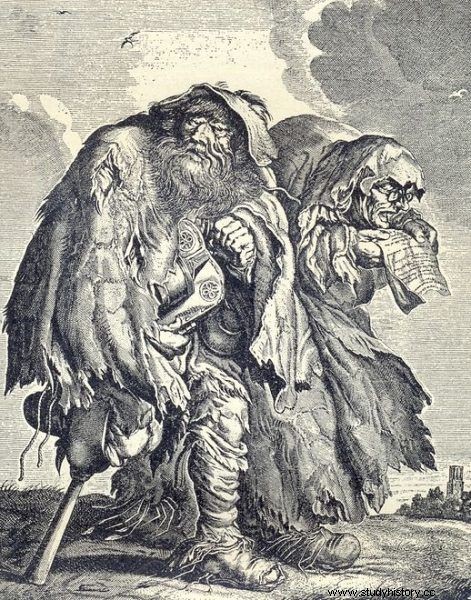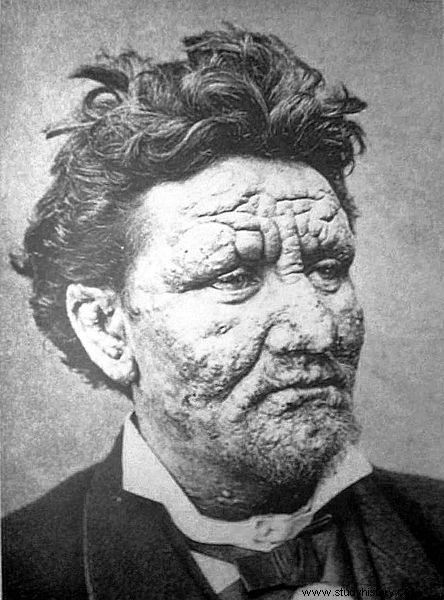Of the many dreadful diseases that plague mankind, leprosy is one of those formerly most feared. Why?
The cause of leprosy are bacteria - Mycobacterium leprae, which settle safely inside the host's cells. They cannot survive outside of them, nor do they secrete spores or have the ability to move. The only way to contract the disease is direct contact with the sick person or inhaling the contaminated aerosol, and yet - in the 4th century, large groups of people were forced to create specially separated, closed colonies for lepers:leprosarium .
The incubation period of leprosy bacteria is very long, reaching even 20 years, and yet at that time it was widely considered an infectious disease. The fear of leprosy was intensified by the terrible deformities of the sick and the unpleasant odor emitted by their dead tissues - hard to believe that something like this could be a product of nature ... The answer was simple:leprosy must be God's punishment for sinners!
The disease is as old as the world
Today it is believed that leprosy has accompanied mankind for thousands of years. The disease probably originated in East Africa or the Middle East, and has spread throughout the world with the emergence of new trade routes. Modern scientists know four strains of Mycobacterium leprae, one of which appears predominantly in East Africa, Asia and the Pacific, the second in Ethiopia, Malawi, Nepal and New Caledonia, the third in Europe, North Africa and the Americas, and the fourth in West Africa and in the Caribbean.
The word "leprosy" comes from Greek and literally means "the disease that makes the skin scaly." One of the first known notes on leprosy dates back to around 460 BC, and its author is Hippocrates. There are also documents that the disease was known and described at the same time in China, Egypt, Israel and India.

The lepers were subject to social ostracism
It was only during the Crusades that the social attitude towards the infected changed. King of Jerusalem, Baldwin IV fell ill (he went down in history with the nickname "The Leper"), and disgust soon turned into a Christian obligation to help the sick. Masses for the dead were no longer celebrated over them (which was previously unpleasant because the infected were considered "walking dead"). The obligation to divorce was also abolished, and instead of locking up the lepers and waiting for their death, efforts were made to help them as much as possible - although still in isolation.
The real cause of the disease was discovered by Gerhard Armauer Hansen, a Norwegian scientist who worked at the hospital for lepers in Bergen. In the second half of the nineteenth century, he was able to observe leprosy bacteria in the tissue fluid collected from patients and later prove that they are the cause of the disease. Thanks to this, today we can treat the infected with drugs that target Mycobacterium leprae, and the WHO provides free access to basic remedies.
One way ticket
The peak of the number of functioning leprosariums was in the Middle Ages, until the outbreak of the Black Death epidemic in the 14th century. In France alone, between the 12th and 13th centuries, there were about 2,000 such institutions. Back then, placing the sick in closed complexes was obligatory. The sick were treated as untrustworthy and morally spoiled (after all, God had to punish them for something), which was reflected even in the decisions of the Third Lateran Council of 1179 or the edict of King Edward of 1346:both documents forbade lepers from entering the cities.
Patients were assessed by a specially appointed committee whose task was to determine whether a given person was actually ill. If the test result was positive, a document was issued authorizing the person to enter the gate of the lepers' home. This provided additional protection against the homeless who might try to find shelter in such a place and then spread the plague.

This disease terrified people…
The new inhabitants of the leprosarium were greeted with a mourning mass for their death, after which they learned what they were not allowed to do from then on. They received a set of personal items that they used on a daily basis to limit contact with the belongings of others. The leper could also wear one set of clothes assigned to him, and he had to carry a knocker or a bell with him at all times - to let people know when he was there. The infected were not allowed to appear in assembly places, such as markets or churches. They created closed communities based on common goods and the principles of equality.
Paradoxically, the leprosy epidemic was ended by another misfortune that befell people in the 14th century. The number of patients decreased drastically during the Black Death epidemic. Weakened organisms of people confined in a limited, not very hygienic space simply did not endure and ... most of them died. Most of the leprosariums in Europe were closed then.
However, some remained active and functioned as refuges and centers for research into treatment options. There have even been situations where a separate currency was minted especially for the leprosarium - this was the first time in 1901 in the Colombian leprosariums Agua de Dios, Cano de Loro and Contratacion. Later, a similar idea was implemented in the United States in 1919–1952, as well as in the Philippines in 1913–1930, Japan from 1919 to 1955 and Malaysia from 1936 to 1938. This kind of action came from the belief that leprosy bacteria could spread on money and thus penetrate the walls of leprosariums. Subsequent studies showed that dispersion in this way was practically impossible and the creation of internal monetary systems was abandoned.
Today, one facility called Tichilesti, located in the city of Isaccea, Romania, remains open in Europe. In Asia and Africa, in places where medical care is not yet at a high level and resources for medicines are still scarce, there are still many leprosy.
Blood, venom and oil
There are also examples of quite drastic attempts at treating lepers, the oldest of which come from ancient times. The ritual of bathing in blood, which was supposed to restore health, probably originated in Egypt - this was also adopted by the ancient Greeks and independently in the same way they tried to cure a sad disease in ancient China. Worse still, the procedure required the blood of children or virgins, which was supposed to be a "pure" medicine. Even in 1790, similar treatments were used, but in this case using the dog's blood, as we read in De Secretis Naturae. Paracelsus recommended sheep blood.
A completely different approach was taken by the supporters of venom treatment. In the first century AD, Pliny the Elder or Areteus of Cappadocia recommended the use of cobra venom. Sometimes, instead of snakes, treatments were also tried with scorpions or frogs, and even with the secretion of anabas (a species of freshwater fish). Such experiments continued until the beginning of the 20th century, when Boinet tried to treat lepers by administering ... extreme doses of bee stings . Apparently, he recommended about 4,000 stabs per person.

People with leprosy were mostly isolated
Fortunately, there are also many successful attempts in history. Chaulmoogra oil was used in India, China and Burma for various skin ailments, and it reached the European market in the 19th century thanks to Frederic John Mouat from the Medical University of Bengal. Long and arduous studies involving taking the drug orally (extremely difficult due to the taste) and attempts to increase its bioavailability resulted in the cure of many patients in the 20th century (the first recorded cured case in 1900 can boast the personal physician of Sultan Hussein Kamel of Egypt, Tortoulis Bey, who after 6 years of regular injection of the oil, the patient finally recovered). Chaulmoogra oil remained the most effective method of fighting leprosy until the 1940s.
A medicine that guarantees much greater effectiveness was produced in 1940, although it is not entirely certain which scientist and from which university is responsible for it. The drug was called Promin, which decomposed in the patient's body and thus released dapsone. Soon, in 1950, Dapsone (4,4′-sulfonyldianiline) was isolated, acting as an antibiotic in the treatment of leprosy as well as in the prevention of malaria, pneumocystosis and a number of other diseases. It is currently used in combination with the later invented rifampicin and clofazimine.
Nevertheless, even today it is difficult to estimate the number of cases of the disease due to the very long incubation period. India is the most common leprosy (60% of cases), followed by Brazil (13%) and Indonesia (8%). It is estimated that in 2018 leprosy occurred in over 200,000 people. However, this is a big step forward compared to the 1960s, when the number of cases was counted in the tens of millions.
Bibliography:
- Asbridge, T., The Crusades. War for the Holy Land. Krakow, Astra Publishing House, 2015.
- Cianciara, J., Juszczyk, J., Infectious and parasitic diseases. Lublin, CZELEJ, 2007.
- Cywiński, P., Kolonia zaklętych, direct.pl, March 21, 2004.
- Janaszek, W. Perspectives for the elimination of leprosy in the world. Epidemiological Review, 2002.
